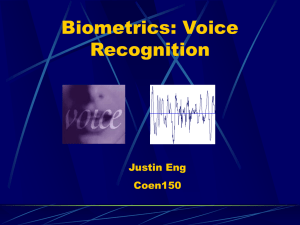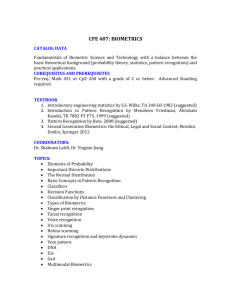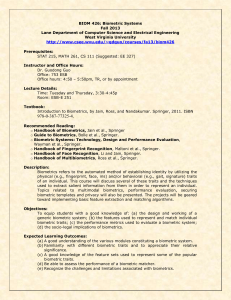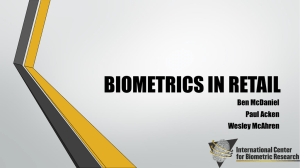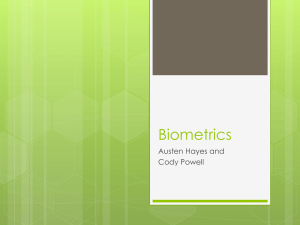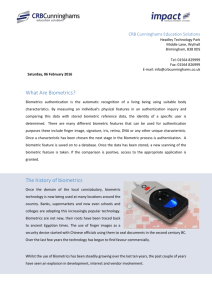Biometrics: Voice Recognition
advertisement
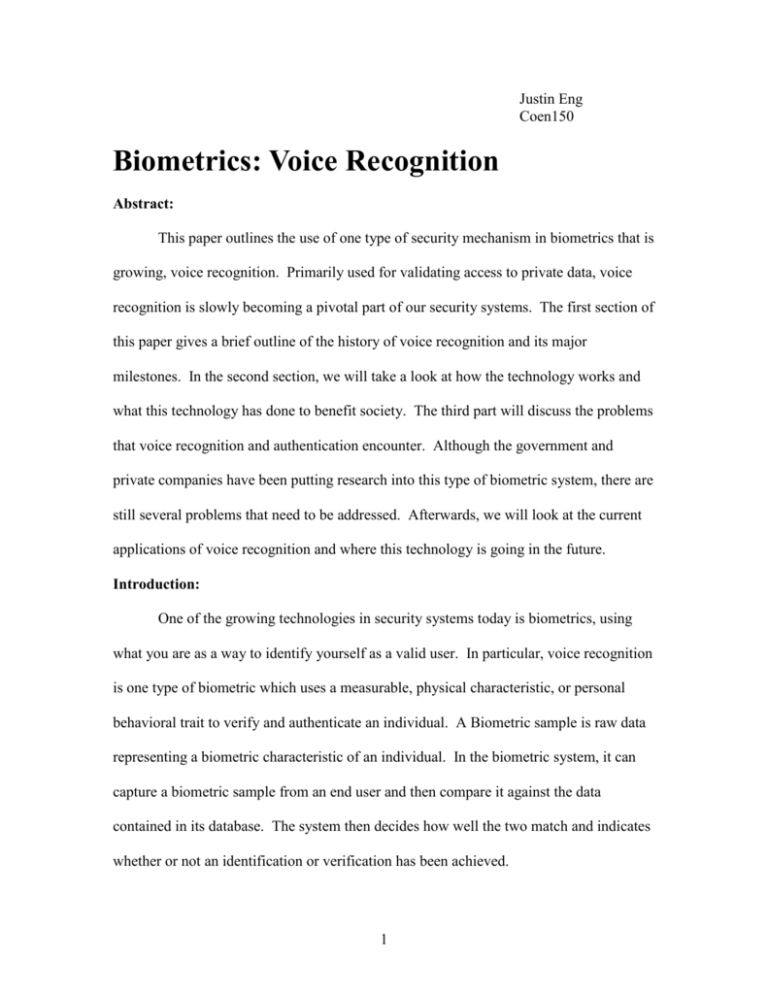
Justin Eng Coen150 Biometrics: Voice Recognition Abstract: This paper outlines the use of one type of security mechanism in biometrics that is growing, voice recognition. Primarily used for validating access to private data, voice recognition is slowly becoming a pivotal part of our security systems. The first section of this paper gives a brief outline of the history of voice recognition and its major milestones. In the second section, we will take a look at how the technology works and what this technology has done to benefit society. The third part will discuss the problems that voice recognition and authentication encounter. Although the government and private companies have been putting research into this type of biometric system, there are still several problems that need to be addressed. Afterwards, we will look at the current applications of voice recognition and where this technology is going in the future. Introduction: One of the growing technologies in security systems today is biometrics, using what you are as a way to identify yourself as a valid user. In particular, voice recognition is one type of biometric which uses a measurable, physical characteristic, or personal behavioral trait to verify and authenticate an individual. A Biometric sample is raw data representing a biometric characteristic of an individual. In the biometric system, it can capture a biometric sample from an end user and then compare it against the data contained in its database. The system then decides how well the two match and indicates whether or not an identification or verification has been achieved. 1 For voice recognition biometrics, it is important to note the difference between speech recognition and speaker verification. The most important difference is that speech recognition identifies what you are saying, while speaker verification verifies that you are who you are saying. A speech recognition system is designed to assist the speaker in accomplishing what that person wants to do. If the person is using speech recognition to dictate a report, the system is expected to accurately record what that person is saying. For example, if the person is speaking to a typing program and says, “Voice recognition is one type of biometric security,” then the system is expected to accurately record that phrase. However, if an application needs to know who is speaking, then it must authenticate the person and verify that he or she is in fact that person. Speaker verification and authentication systems are voice biometrics. Like other biometrics such as fingerprints, face recognition, signature verifications, speaker verification systems are used primarily for security or for monitoring. To perform these functions, a speaker verification system will ask the speaker to say one or more passwords or to repeat a series of words or numbers. Speaker verification systems cannot tell whether the person has said what the system expects him or her to say. In order to do that, they must submit the spoken input to a speech recognition system. If speech recognition and speaker verification are combined, a voice recognition system can be created as seen in figure 1. 2 Figure 1. History of voice recognition: The beginning of voice recognition can be attributed to a little dog called Radio Rex who was created by the Elmwood Button Company in 1922. The dog functioned by calling its name “Rex,” so that it would react and move to the user’s voice. Initially, the dog consisted of a metal plate that contained an electromagnet. Using the magnet as the key to their invention, the Elmwood Button Company created a current that energized it to flow through a metal bar. If a certain amount of energy or current was sent through to the metal bar, then it would cause the dog to react. For example, in the vowel of the word “Rex,” there was enough energy present to interrupt the current and trigger the robotic dog (History of speech recognition). Needless to say, Radio Rex was not a commercial success because the technology was new. However, the device paved the way for the voice recognition technologies to follow. During the 1940’s and 1950’s the United States Department of Defense and MIT became the largest contributors to the speech recognition field. Also, in 1936, AT&T’s Bell Labs developed the first electronic speech synthesizer. This voice coder called Voder, was designed to mimic the speech sounds humans generate as air passes from the lungs through the larynx and out from the mouth (Talking heads, the early history of 3 talking machines). The Department of Defense on the other hand, was driven by an interest in automatic interception and translation of Russian radio transmissions. Although the actual output of their device generated inaccurate translations, it was a start to voice recognition in combat (Speech recognition history). The primary developments of voice recognition in the 1960’s and 1970’s can be attributed to the educational institutions. Most notably MIT and Carnegie Mellon, these two schools contributed a massive amount of time, effort, and money into this field of research through the aid of the United States Defense Department because they had an interest in speech research (Timeline of Speech recognition). Later in 1975, Jim Baker from Carnegie Mellon developed a revolutionary “Dragon Speech” recognition model. IBM used his research and continued to pioneer their own statistical approach to speech recognition. Thus, by 1985 they had developed the world’s first speech recognition system which was capable of discerning 5000 different words and phrases (History of speech recognition). Today, voice recognition and authentication systems have become further developed because of our society’s needs. Since computer have been incorporated into our everyday lives, a need for security in computer systems has greatly increased. Thus, a new form of security has been developed and is further being developed, voice recognition biometrics. Voices are Unique: In order for voice recognition to work, the biometric system must be able to distinguish between various people’s voices. Since human voices produce a simultaneous series of harmonics, each sound can be attributed to a different person. 4 One of the key components that voice recognition uses in order to authenticate a person is by using the person’s frequency and intensity. A person’s frequency is the speed at which air particles vibrate. Since humans can only produce and hear frequencies from 60 to 16,000 cps, a voice recognition system can use this scale to help verify users. Another technique used for recognition is by recording a person’s intensity, or the amount of energy in a sound wave. Since the variation in intensity does not affect the frequency, then two sound waves can never be recreated even if it is by the same person. Yet another reason why every person’s voice is unique is because we have different resonators and articulators. Resonators refer to our body’s nasal, oral, and pharyngeal passages whereas articulators refer to such things as our lips, teeth, tongue, and jaw muscles. In order to develop our speech when we were born, we had to train our resonators and articulators in such a way that when we speak, our brain process’ that request automatically. Thus, there is no real such thing as spontaneous speech because everything is controlled by our brains. Voice recognition systems use this to its advantage because a person will not be able to duplicate another person’s voice. Even if someone tried to disguise their voice, the brain would control their resonators and articulators, or their speech habit so that the sound cannot be mimicked. How Does Voice Biometrics Work? Since voices are nearly impossible to recreate, voice biometric systems analyze a person’s voice to authenticate the person and see if he or she is in fact that person. Voice recognition systems operate by digitizing a profile of a person's speech to produce a “voice print,” something which is referred to each time that person tries to gain access to secure data. This biometric system uses technology which reduces each spoken word 5 into smaller segments such as syllables. Within these smaller segments, each part has three or four dominant tones that can be captured in a digital form and plotted on a spectrum. This table of tones then yields the speaker's unique voiceprint. The voiceprint is then stored as a table of numbers, where the presence of each dominant frequency in each segment is expressed as a binary number. Since all table entries are either a 1 or 0, each column can be read bottom to top as a long binary code. When a person speaks his or her secret phrase, the code word or words are extracted and compared to the stored model for that person. When a user attempts to gain access to protected data, their secret phrase is compared to the previously stored voice model and all other voiceprints stored in the database. If the voice matches according to the system’s “error correction” number, then it will be determined whether or not the person is authenticated. Voice Recognition Algorithm: Voice recognition is able to work because of the algorithm it performs to digitally verify if the voice matches. This can be done in several different ways, but in our case, the first step is when the digital signal is passed through a low-order filter to spectrally flatten the signal and to make it less susceptible to infinite precision effects. The transfer function of this filter is: The value for a usually ranges from 0.9 to 1.0. For this particular example, a = 0.9375. The signal is then put into frames which are 256 samples long. This corresponds to about 23 ms of sound per frame. Each frame is then put through a Hamming window. 6 Windowing is used to minimize the discontinuities at the beginning and end of each frame. The Hamming window has the form: where N is the number of samples per frame. In this system N = 256. In the third step, each windowed frame is auto-correlated. This is done to minimize the mean square estimation error done in the LPC step. The equation for autocorrelation is: where p is the order of the LPC coefficients. p = 13 in this system. The features for each frame are extracted by linear predictive coding (LPC) which is represented by the following equation: where Sn is the nth speech sample, and the ai the predictor coefficients, and Sn is the prediction of the nth value of the speech signal. This is a finite-order all-pole transfer function whose coefficients accurately indicate the instantaneous configuration of the vocal tract. Cepstral coefficients are obtained from the LPC coefficients. Cepstral coefficients are used since they are known to be more robust and reliable than LPC coefficients, PARCOR coefficients, or the log area ratio coefficients. Recursion is used on this equation to attain the Cepstral coefficients 7 Here p = 13, a k are the LPC coefficients, and c(i) are the Cepstral Coefficients. The Cepstral coefficients are then passed through a parameter-weighting step to minimize their sensitivities. Low-order Cepstral coefficients are sensitive to the overall spectral slope and high-order Cepstral coefficients are sensitive to noise and other forms of noiselike variability. The weighted Cepstral coefficients are in the form: where w m is given by the following equation: Again p = 13 for our system. The result is an i x j matrix, where i is the order of the LPC and j is the number of frames. Now that the important characteristics are extracted, the results can be used by VQ and DTW to compare the speaker and word respectively. Thus if VQ and DTW match, then the system should accept the voice as the authenticated user. (*Information concerning this voice recognition algorithm was found in the “Voice Recognition and Identification System Paper”) Trying to Fool Voice Recognition Systems: Since our voices are unique and through voice recognition algorithms, voice biometrics should be able to tell the differences between real and fake users. One of the concerns about voice recognition systems is the threat of recording a person’s voice. 8 Although this is a concern, most speaker verification systems have anti-spoofing built into their system. This is a way to test for live-ness, and whether or not the person is real. In order to detect this, the systems look for acoustic patterns that suggest that the voice has been recorded. If there are several mismatches on the system, or if the company wants to use further protection and security means, then they can also use a text-prompted challenge response mechanism. In this type of security measure, the system would randomly select a set of words for the user to repeat. Thus, by asking the user for a new input phrase to say, it would help prevent record and replay attacks. Benefits of Voice Recognition Systems: Biometric voice recognition systems add another layer of security for computer systems in an age where computer security needs to be high. Although this technology is new, it can still provide a means of security for various purposes. As seen in the figure below, voice recognition is a new form of security, biometrics, which should be used in conjunction with previous forms of security mechanisms. This figure displays the new and increasing level of security mechanisms for computer technology 9 In addition to security, voice biometrics can produce a more efficient and cost effective environment. In one case, a voice recognition system would allow companies to spend less money by providing them with employee ID access cards. It can also help companies be more productive with their time. Instead of using passwords or PIN numbers which might be forgotten, a voice recognition systems reduces technician support (of resending passwords) because they can merely talk into the device to be authenticated. Also, with today’s volatile working market, administrators can delete voiceprints of former employees easily and effectively so that no time is lost in productivity (Department of Homeland Security Is The Catalyst For The Biometric Industry). Through the new innovation of voice recognition technology, it offers network administrators new opportunities to enhance user authentication methods, password control, and various network security applications. In a society which relies heavily upon computers in order to function, the need to protect sensitive information will undoubtedly act as a catalyst to produce more secure biometric devices. Problems with Voice Recognition Biometrics: Although voice recognition is a highly researched field of computer security, there are still some flaws and problems that this type of security encounters. According to Joseph P. Campbell, today’s biometric identification systems have error rates ranging somewhere between 6% to 29% of the time (Campbell). One of the first problems that voice recognition systems encounter is the fact that human voices do not necessarily remain the same over one’s lifetime. People’s voices may be effected because of stress, colds, or allergies, as well as by aging and diseases. In 10 order to try and fix this problem, the system could update the user's speech model with each successful login. Another problem that has to be addressed is the uses of microphones. No two microphones perform identically, so the system has to be flexible enough to cope with voiceprints of varying quality. If a person records the voice prints into the system’s database using one microphone, then that may effect the voice print if the person were to use a different microphone at a different location. Also, the same person will not speak the secret phrase exactly the same each and every time, so there must be a compensation rate to accept or deny the user. Environmental noise can also contribute to problems of voice recognition systems. Although humans can focus on a particular sound, a computer system must take all information or data that it receives. Computers will then have to try and distinguish sounds heard from the microphone, and those from outside environmental noises. Any extra or outside interference can cause the system to not authenticate a valid person. Other problems that occur in voice recognition systems are poor phone, or cellular connections, vocal variations among people, and telephone devices. With cellular phones, the connection may not be the greatest and so static may cause an interference. Vocal variations can also be a problem because accents are hard to distinguish. Telephone devices can also effect the success of voice biometrics because of the voice samples that are converted and transferred from an analog format to a digital format for processing. 11 Current Applications of Voice Biometrics: Voice biometrics are slowly being incorporated into today’s computer security defenses. As more computer driven applications arise, voice biometrics can be applied to them as a means to add another layer of security. As of now, most current applications for voice recognition systems are for physical access entry into a building or for private data. Aside from gaining access into physical buildings, voice biometrics are also being incorporated into a vast assortment of environments. The first case is the penal system where authentication is used for inmates on parole, juvenile inmates, and those under house arrest. Another application that is being used today is telecommunications and telephone companies using voice-enables services. These include AOL, Orange, Onstar, Visa International, and AT&T. Services include voice activated dialing, and password security validation and authentication for interactive billing (Lernout & Hauspie speech products announces license agreement with orange). A second application for voice biometrics is M-commerce. In this system, a voice and signal provider created a security architecture safeguarding access to handsets by means of voice authentication. This new system is impressive because it can run on a SIM card and requires no additional hardware. This technology ensures that only legitimate users can access a phone by using a locking mechanism. Authentication requires the user to speak a phrase or word as the phone is switched on, which is compared in real-time with a reference voice print stored inside the tamper proof SIM card's memory (Schlumberger Delivers Timely Breakthrough in Mobile Security with On-card Voice Authentication for Phone Users). 12 The law enforcement and government are also using voice recognition in their services. Voice authentication is used in the law enforcement and corrections industries for positive confirmation of offenders’ presence in their home. This guarantees the law that the person is following the court’s orders or confinement to their house. Voice verification in telephone banking is slowly growing with customer interest because they are willing to try a new means of securing their money. This type of application is becoming more attractive to banks and other financial institutions as developers start to implement highly cost effective automated speech recognition systems to handle routine transactions like an ATM machine. Another interesting application of voice recognition systems that is already being implemented is credit cards. These credit cards will not work unless it hears its owner’s voice. By requiring users to give a spoken password to authenticate the user, it prevents thieves from trying to use a stolen card. (Gizmodo) This voice card, or “beep card” as it is called, uses a built-in loudspeaker that it uses to “squawk” an acoustic ID signal via a computer’s microphone to an online server (Visa to get behind Voice authentication). Voice Recognition on the Rise: Although voice recognition is not the most commonly used biometric in computer security today, its applications to the real world are slowly growing. In fact, there are some indications that voice recognition could become one of the most accepted and used biometrics in our society. A recent study conducted by Vocent Solutions, Inc. suggested 13 that: (1) Telephones are the primary means by which consumers will conduct financial transactions and access financial account information; (2) Consumers know about the problem of identity theft; (3) Consumers feel that PIN Numbers and passwords are not secure enough; (4) A strong amount of concern exists when communicating confidential information over the telephone; (5) As a result of these security concerns and fears, consumers would be willing to participate in a voice recognition system, and also feel that it could potentially reduce fraud as well as identity theft. (NOTE: The source of this information is from the Biometric Media Weekly, October 6th issue). ( Department of Homeland Security Is The Catalyst For The Biometric Industry) 14 Voice recognition is on the rise as it has slowly been improving on its accuracy rates and meeting users’ needs for applications. Allied Business Intelligence (ABI) projects voice recognition biometrics to increase to $897.8 million in 2003, up from $677 million in 2002. Over the longer term, the speech recognition market is forecasted to grow to $5.3 billion by 2008 (Speech Recognition Market To Exceed $5 Billion by 2008). Conclusion: The main purpose and benefit of a voice recognition system is the amount of security that it provides. Although voice recognition is mostly secure, it still has flaws. To aid its acceptance, this biometric system can be combined with more traditional security features to provide an additional layer of security. These can include using other biometrics, or security mechanisms such as RSA’s Security token, PINs or a combination of several different mechanisms. Through further development, voice recognition can be one of the most successful and largest applications of biometrics in the future to come. 15 References: 1) http://www.stanford.edu/~jmaurer/history.htm, History of speech recognition, accessed 05/13/04. 2) http://www.haskins.yale.edu/haskins/HEADS/simulacra.html, Talking heads, the early history of talking machines, accessed 05/13/04. 3) http://florin.stanford.edu/~t361/Fall2000/jgolomb/YYSpeechHistoryWB.htm, Speech recognition history, accessed 05/13/04. 4) http://www.emory.edu/BUSINESS/et/speech/timeline.htm, Timeline of Speech recognition, accessed 05/13/04. 5) http://www.netbytel.com/literature/e-gram/technical3.htm, History of speech recognition, accessed 05/13/04. News articles: 6) http://www.alliedworld.com/abiprdisplay.jsp?pressid=124&filename=bim02pr2.pdf, Department of Homeland Security Is The Catalyst For The Biometric Industry, According To New ABI Study, December 17th 2002, accessed 05/13/04. 7) http://www.alliedworld.com/abiprdisplay.jsp?pressid=132&filename=srs03pr.pdf, Speech Recognition Market To Exceed $5 Billion by 2008, According to New ABI Study, February 5th 2003, accessed 05/13/04. 8) http://www.voicerecognition.com/news/07_26_01.html, LERNOUT & HAUSPIE SPEECH PRODUCTS ANNOUNCES LICENSE AGREEMENT WITH ORANGE, accessed 05/13/04. 9) http://www.cyberflex.com/News/Mobile_Security_News/mobile_security_news.html, Schlumberger Delivers Timely Breakthrough in Mobile Security with On-card Voice Authentication for Phone Users, February 19, 2002, accessed 05/13/04. Papers and publications: 10) http://www.ece.cmu.edu/~ee551/Final_Reports/Gr11.551.S00.pdf Voice Recognition and Identification System, (Text Dependent Speaker Identification), Accessed 05/13/04. 11) http://www.gizmodo.com/archives/voice-recognition-capable-credit-card015388.php, Credit Card Authentication Systems, accessed 05/14/04. 16 12) “Speaker Recognition”, Joseph P. Campbell, Jr. Article is from the book: “Biometrics: Personal Identification in Networked Society”, By Anil Jain, Ruud Bolle, and Sharath Pankati. 13) http://archive.infoworld.com/articles/hn/xml/02/10/21/021021hnvisa.xml, Visa to get behind Voice authentication, October21st 2002, accessed 05/13/04. Miscellaneous sources: 14) http://biometrics.cse.msu.edu/speaker.html, Speaker Verification, accessed 05/13/04. 15) http://www.jmarkowitz.com/ask.html, What is voice recognition?, accessed 05/13/04. 16) http://www.siliconvalley.com/mld/siliconvalley/4332656.htm, Voice-authentication company makes deal with Visa, October 21st 2002, accessed 05/12/04 (Vocent strikes deal with Visa International). 17

